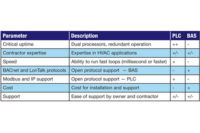Chilled water plants tend to be one of the most energy intensive areas of a commercial building. These plants can range from fairly basic to very complicated. Despite the importance of these plants for efficient building operations, we find that many plants are operated manually, and even those that are automated often are not operating at peak efficiency.
The key to chiller plant optimization is to remember that the meter is on the plant, not the chiller. This means looking for ways to meet the building loads reliably, and using as little energy as possible.
While each plant is different, the basics of efficient operation can be applied to any plant. Here are the fundamentals you should consider when developing a design for automating and optimizing a chiller plant.
Chilled Water Pump Control
Ideally, chilled water flow to the building should be variable flow, and the chilled water pumps should be controlled based on the differential pressure near to the end of the loop. This pressure can be used to sequence pumps as needed. Often, existing plants can be converted to variable flow, but care needs to be taken to make sure that the chillers have adequate flow, either through the use of constant flow primary pumps or with flow measurement for variable primary systems.
Condenser Water Control
In a water-cooled chiller plant, the goal is to effectively produce chilled water while rejecting the heat though the tower. This work is shared between the tower and the chiller. For example, in a conventional plant, the chiller might produce 45ºF chilled water temperature using 80ºF condenser water. In general, the tower is much more energy efficient than the chiller. Lower condenser water temperature allows for the chiller to provide the same 45ºF water using less energy. Of course, reducing the tower setpoint will require the tower fans to use more energy, but the plant overall will use less energy. Condenser water reset is a great strategy, but you need to be careful about the capability of both the chillers and towers as to how much reset is possible.
Machine Sequencing
Chillers should be staged based upon the load of the plant, available machines, and efficiency. The goal is to run the most efficient combination of machines at all times. Sequencing can be complicated and requires an understanding of the plant goals and the efficiency curves of each machine. For example, it is desirable to even out the run hours on machines, while at the same time getting the best potential efficiency.
Chiller plant automation is not complicated or magical. However, it does require a careful focus on the basics outlined above, along with details about the ability of the chillers, towers, pumps, and operating characteristics of the building or campus.




